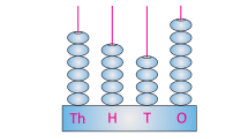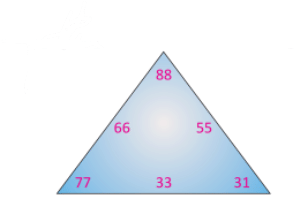Olympiad Test Level 1: Fun With Numbers - Class 3 MCQ
20 Questions MCQ Test - Olympiad Test Level 1: Fun With Numbers
The difference between the place value of 6 and 9 in the number 6593 is:
How many tens need to be subtracted from 5930 to get 230 ?
If the digit at hundreds place is interchanged with the digit at one place of the number shown by the abacus, then find the difference between the new number and the original number.


The greatest four digit number using digits 3, 6, 8 and 0 without repetition is:
The sum of greatest two-digit number and smallest one digit number is:
The largest two digit number whose tens place is even and ones place is odd is:
What is the place value of the underlined digit in the number given below
3 4 6 7
Find the smallest three-digit number from the following:
571, 517, 715, 175
Reena had four numbers (4, 7, 9, 5). She used each number only one time to make a large number. If she put 9 at ten’s place, what would be the largest number she could make?
What is The difference between place value and face value of 4 in the number, 3451?
Find the largest three-digit number from the following:
398 , 983 , 839, 893
Arrange the following numbers in descending order:
527, 708, 107, 483, 96.
Subtract the smallest number from the biggest number given inside the triangle.

The expanded form of the number 55432 is:
Choose the correct number name for the given 87,162.
Find the largest 4-digit even number that can be formed using the digits 2, 3, 5 and 6 (use each digit only once).
Identify the predecessor of the number N.














